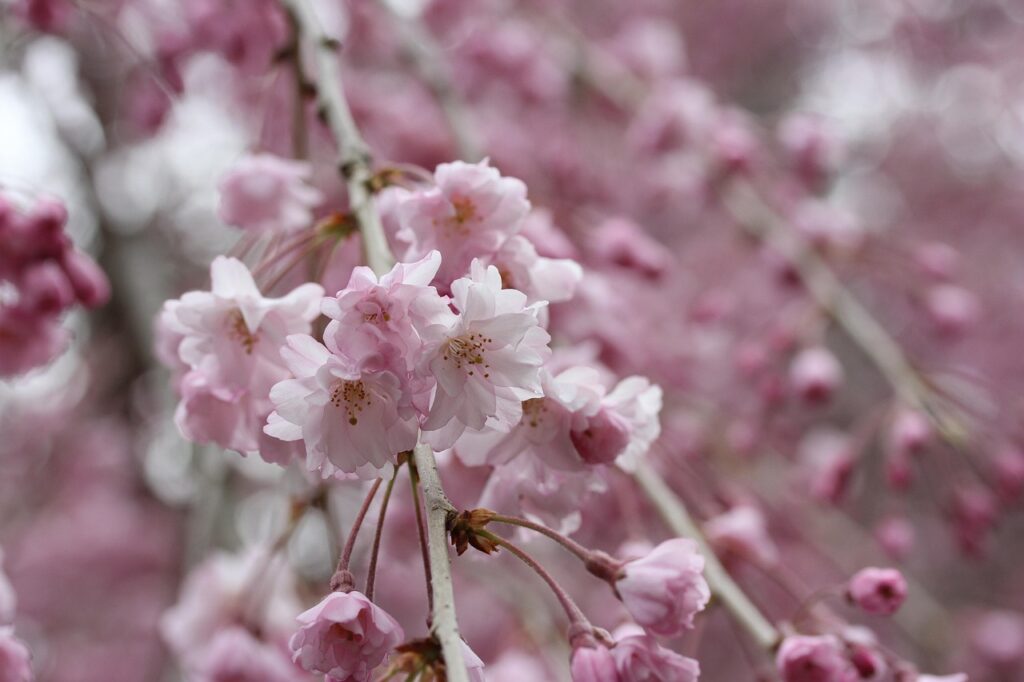The weeping cherry tree (Prunus subhirtella ‘Pendula’) is ever-so-important for ease of culture, elegance and character to your garden. The first time you see a weeping cherry tree with its soft pink or white blossoms in springtime, cascading elegantly from its arching branches, you will be amazed and enchanted. Once you see it, you will wonder how you can grow a weeping cherry tree – especially if you don’t know much about gardening.
Whether you have a large backyard, or small front lawn, this complete guide to growing a healthy and beautiful weeping cherry tree will help you establish one in any style of garden.
Why Choose a Weeping Cherry Tree?
Aesthetics : Beautiful arching branches; gorgeous springtime blooms
Size : Best for smaller to medium sized garden
Ease of care : If established properly, maintenance should be easy
Seasonal Interest : Spring blooms; green foliage in summer; gorgeous golden leaves in autumn.
How to Plant a Weeping Cherry Tree
- Picking the Right Spot
Sun: Full sun (at least 6 hours/day)
Soil: A well-draining site; slightly acidic to neutral (pH) range is best
Space: Allow at least 10–15 feet for tree spread and air movement. - When to Plant
The weeping cherry will succeed best if the ground is imperative when planted in early spring or fall; allowing the tree time to establish a root structure before temperature extremes.
- How to plant
Dig a hole twice as wide and deep as the root ball.
Mix compost into the soil to provide more nutrients to the tree.
Place the tree into the hole and ensure that the root collar level is at soil surface.
Backfill the hole, water thoroughly, and mulch around the base (don’t mound the mulch up against the trunk; 2 – 3 inches away is best).

Caring for a Weeping Cherry Tree
Watering
Young trees: Deep soak 1-2 times per week
Mature trees: Water during dry spells or extended periods without rain, but do not overwater
Fertilizing
Add a balanced slow-release fertilizer at the beginning of spring.
Do not over-fertilize your weeping cherry since excess nitrogen will cause excessive leafy growth and less flowering.
Pruning
Pruning is best accomplished in late winter or early spring before the new growth has begun.
Remove:
Dead or diseased branches
Suckers growing up from the base
Branches that rub against each other or cross each other
Gently shape them in order to keep the “weeping” shape
Pest and disease control
Watch for:
Aphids, borers, or spider mites
Fungal diseases like leaf spot or powdery mildew
You may also use neem oil or horticultural soap for pest control where recommended.
In order to manage a fungal disease, be sure that you have good air circulation and do not overwater your weeping cherry tree.
Bloom Period and Expectations
Bloom Time: Early- to mid-spring (March-April)
Flower Colors: pale pinks, bright pinks and white – depending on the variety
Lifespan: If properly cared for, a weeping cherry tree can live 20-30 years or more.
Design Tips: Placement
Centerpiece of the front yard or garden
Alongside walkways or ponds for reflection and balance
Back drops for flowerbeds
In combination with tulips or daffodils for layers of spring color.
Common Varieties of Weeping Cherries
Snow Fountains (Prunus ‘Snofozam’) – compact, white blooms
Pendula Rosea – traditional pink-flowered variety
Hiromi Weeping Cherry – dwarf variety suitable for containers or smaller applications.
Best Practices
Always mulch to retain moisture, and eliminate weeds.
Stake young trees if they are at the mercy of wind.
Be patient – it usually takes at least 2-3 years of growth before you see the tree in its full blooming splendour.
Conclusion: A Tree to Grow
A weeping cherry tree is an ornamental that is more than just a plant – it is a thing of elegance, a joyful presence of spring, and a calming personage in any garden. A little planning and consideration will provide you with cascading flowers season after season.
Frequently Asked Questions About Weeping Cherry Trees
Q: Can I grow a weeping cherry tree in a pot?
A: Yes, nursery dwarf varieties (such as Hiromi) are ok for large pots.
Q: Will a weeping cherry tree lose its leaves?
A: Yes, they are deciduous trees that will drop its leaves in fall.
Q: Do weeping cherry trees produce edible fruit?
A: Most weeping cherry trees are ornamental and do not have edible fruit.
